Today’s Current Affairs: 12th August 2025 for UPSC IAS exams, State PSC exams, SSC CGL, State SSC, RRB, Railways, Banking Exam & IBPS, etc
Table of Contents
Mississippi River: Two people died

Two people died when a helicopter crashed into a barge in the Mississippi River near East Alton, Illinois, recently.
- Mississippi River is the longest river in the United States and the second longest in North America.
- It starts at Lake Itasca in northern Minnesota and flows south until it reaches the Gulf of Mexico.
- The major tributaries are the Red, Arkansas, Illinois, Missouri, and Ohio.
- The Mississippi River alone is more than 2,300 miles (3,700 kilometers) long.
- If the length of the Missouri River system is added, the Mississippi-Missouri is the world’s fourth longest river system, following the Nile (4,160 miles/6,693km), the Amazon (4,000 miles/6,436km), and the Yangtze Rivers (3,964 miles/6,378km).
- The Mississippi River basin drains 1,260,000 square miles, making it the largest drainage basin in terms of area in North America.
- The basin is home to different ecosystems, including wet forests dominated by cypress trees, brackish and freshwater marshes, sandy beaches, and salt marshes.
Heptapleurum assamicum : New Plant Species

Scientists have recently identified a new plant species in Assam’s Dima Hasao and West Karbi Anglong districts — a lush, evergreen shrub now named Heptapleurum assamicum.
- Heptapleurum assamicum is a new plant species.
- A lush, evergreen shrub, Heptapleurum assamicum was discovered in Assam’s Dima Hasao and West Karbi Anglong districts.
- It belongs to the family Araliaceae, which also includes the familiar ornamental “umbrella plant” (H. arboricola).
- However, this wild Assamese relative carries several distinctive traits:
- Its leaflets are narrow and lance-shaped, never more than 1.2 cm wide.
- Its flowers are a striking purple rather than the greenish-yellow of its ornamental cousin.
- Its compact inflorescences bear up to 15 flowers per umbel.
- The fruit, when ripe, turns a deep reddish-purple and is speckled with orange-red glands — an unusual feature even within the genus.
- The plant flowers between January and March, with fruits ripening by May.
- Its current known population is tiny and highly localised, making it potentially vulnerable to environmental changes.
- For now, it has been categorised as “Data Deficient” under IUCN criteria.
MANAS Helpline:
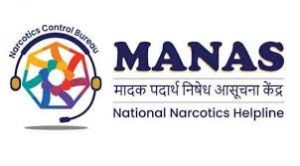
The Minister of State in the Ministry of Home Affairs informed the success of MANAS Helpline in the Rajya Sabha.
- Madak-Padarth Nished Asoochna Kendra (MANAS) Helpline was launched on 18th July 2024 by the Government of India.
- It empowers citizens to fight against the drug menace and to function as a secure, citizen-centric platform to enable anonymous reporting of drug trafficking, illicit cultivation, and related offences.
- MANAS Helpline also extends support for counselling and rehabilitation, thereby strengthening the participation of citizens in combating the drug menace.
- It is developed as a unified, secure and bilingual digital platform, MANAS offers citizens a seamless, confidential and multi-channel interface to report drug-related issues and access rehabilitation resources.
- Citizens can utilize the MANAS Helpline for:
- Anonymously report any information related to drug trafficking, storage, manufacturing or cultivation.
- Seek counselling and rehabilitation guidance through integrated transfer to Ministry of Social Justice & Empowerment (MoSJE) Helpline 14446.
- Access awareness resources (posters, videos, brochures) via the MANAS web portal for public outreach.
- Engage in awareness activities, through quizzes, poster-making, and reel-making contests on the MyGov platform, amplifying the Drug-Free Bharat campaign.
S.H.I.N.E. initiative:
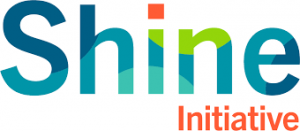
The Department of Health Research (DHR) and the Indian Council of Medical Research (ICMR) organized a nationwide open day titled S.H.I.N.E. initiative.
- SHINE stands for Science, Health and Innovation for Nextgen Explorers which is a nationwide student outreach Program.
- This is a unique initiative of Indian Council of Medical Research (ICMR) to ignite scientific curiosity, foster innovation and inspire the next generation of health researchers.
- The initiative aimed to introduce students to the field of health and biomedical research, highlight ICMR’s contributions to improving the nation’s health, and motivate young learners to pursue careers in science and public health.
- The event drew more than 13,000 students in grades 9-12 from over 300 schools across 39 districts in 16 states and union territories to various ICMR institutes in the country
- The programme included a range of interactive activities such as guided laboratory tours, research exhibitions, poster walks, video presentations, and live demonstrations of ongoing scientific work.
- To make the experience more engaging, a mascot named Dr. Curio was introduced as a friendly and relatable guide for the students.
Sea of Galilee: Turned Red
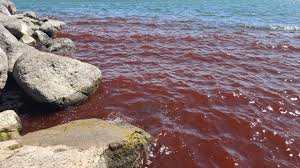
The Sea of Galilee in Israel has turned red due to the bloom of Botryococcus braunii algae.
- Sea of Galilee is a large freshwater lake situated in the northeastern part of Israel.
- It is considered the lowest freshwater lake on the planet and the world’s second-lowest lake after the Dead Sea.
- It is situated in Jordan Rift Valley primarily fed by the Jordan Riverand partly by underground springs.
- Throughout its history, the Sea of Galilee has been referred to by various names such as the Sea of Kinneret, Lake of Gennesaret, Sea of Ginosar, Sea of Tiberias, Lake of Tiberias, Bahr Tubariya, etc.
- It is bordered by the Plain of Gennesaret extends in the north to the northwest, and the Plain of Bet Ẓayda (Buteiha) in Syria extends to the northeast. To the west and southwest, the hills of Lower Galilee fall abruptly to the lake’s edge.
- Botryococcus braunii is a species of single-celled green algae found in freshwater or brackish lakes.
- It is characterized by its ability to produce significant quantities of hydrocarbons and its formation of biofilms that consist of polysaccharides and biopolymers for structural support and protection.
2024 Annual Groundwater Quality Report:
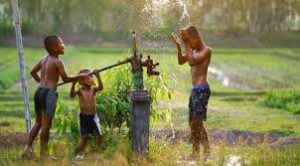
The 2024 Annual Groundwater Quality Report by the Central Ground Water Board’s (CGWB) reveals widespread contamination of India’s groundwater.
- With over 600 million Indians depending on groundwater daily this pollution has become a serious public health crisis, not just an environmental issue.
Causes for India’s Groundwater Contamination Crisis:
- Unregulated discharge of heavy metals (lead, cadmium, chromium, mercury) and toxic chemicals from industries pollutes groundwater.
- Areas near industrial clusters like Kanpur (Uttar Pradesh) and Vapi (Gujarat) have dangerously high groundwater toxicity, creating “death zones.” Toxic effluents have caused kidney failures.
- Excessive use of nitrogen-rich fertilizers leads to nitrate pollution. Phosphate fertilizers contribute to uranium contamination in groundwater.
- Leakage from septic tanks and sewage systems contaminates groundwater with pathogens. Faulty sewage treatment plants cause localized outbreaks of waterborne diseases.
- Fluoride, arsenic, and uranium naturally occur in certain geological formations, especially in states like Rajasthan, Bihar, Punjab, and West Bengal.
- Excessive pumping lowers water tables and concentrates pollutants, making aquifers more vulnerable to geogenic toxins and salinity intrusion.
- The Water (Prevention and Control of Pollution) Act, 1974, largely overlooks groundwater, and its enforcement on groundwater pollution is inadequate, allowing polluters to exploit loopholes.
- The CGWB lacks statutory authority, and State Pollution Control Boards (SPCBs) are under-resourced and technically constrained.
- Agencies like CGWB, CPCB, SPCBs, and the Ministry of Jal Shakti work in silos, duplicating efforts and lacking coordination for integrated action.
- Poor Monitoring and Public Awareness: Data collection is infrequent and not publicly accessible, delaying detection and response.
- Poor involvement of local communities and panchayats in monitoring and managing groundwater quality.
India–Middle East–Europe Economic Corridor & Gaza War:
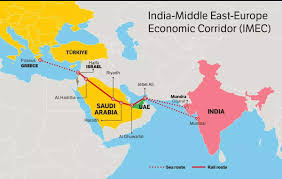
India hosted envoys from partner nations to discuss progress on the India-Middle East-Europe Economic Corridor (IMEC). Talks focused on trade, energy, and digital connectivity despite delays caused by the Gaza conflict.
India–Middle East–Europe Economic Corridor & Gaza War:
- Launched: G20 Summit, New Delhi (Sept 2023).
- Partners: India, Saudi Arabia, UAE, EU, France, Italy, Germany, US, Israel, Jordan.
- Structure:
- Eastern Leg – India’s western ports → UAE (sea) → Saudi Arabia, Jordan (rail) → Haifa, Israel (port).
- Western Leg – Haifa → Greece/Italy (sea) → onward into Europe via existing rail network.
- Key Components:
- High-speed freight rail across the Arabian Peninsula.
- Energy pipelines for clean hydrogen.
- Digital infrastructure (subsea cables, e.g., Blue Raman project: Mumbai–Genoa).
- Trade facilitation measures to boost efficiency and lower costs.
India’s first State-of-the-Art Animal Stem Cell Biobank and Laboratory:
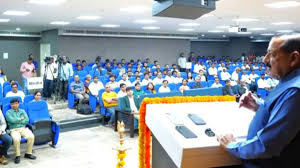
Union Minister inaugurated India’s first State-of-the-Art Animal Stem Cell Biobank and Laboratory at the National Institute of Animal Biotechnology (NIAB), Hyderabad.
- It Is A cutting-edge facility dedicated to preserving, researching, and utilising animal stem cells for regenerative medicine, disease modelling, and reproductive biotechnology in livestock.
- Located in Hyderabad, Telangana
- Situated at the National Institute of Animal Biotechnology (NIAB)
- Organisation Involved:
- National Institute of Animal Biotechnology (NIAB) – under the Department of Biotechnology (DBT)
- Supported by National Biopharma Mission (NBM) of DBT–BIRAC
- Aim:
- Enhance veterinary health innovation through regenerative medicine and cellular therapies.
- Support One Health approach by linking human, animal, and environmental health.
- Strengthen India’s capacity in biotechnology-based agricultural productivity.
Khelo India ASMITA:
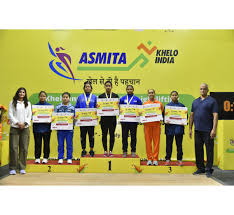
The Khelo India ASMITA Football League 2025-26 was inaugurated in Jalgaon, Maharashtra, marking a major step towards affirmative action in sports to boost women’s participation.
- Khelo India ASMITA is A dedicated affirmative action sports initiative under the Khelo India programme to increase women’s participation in sports, focusing on grassroots talent development, especially among underrepresented communities.
- Launched In: 2025–26, with the inaugural football league in Jalgaon, Maharashtra.
- Ministry: Ministry of Youth Affairs and Sports
- Supported by the Sports Authority of India (SAI), All India Football Federation (AIFF), and Western India Football Association (WIFA).
- Aim:
- Provide a dedicated platform for young girls to showcase and develop sporting skills.
- Address historical gender imbalances in sports participation.
- Foster social inclusion by engaging talent from tribal, rural, and minority backgrounds.
- Contribute to nation-building through women’s empowerment in sports.
16th Lion Population Estimation Report:
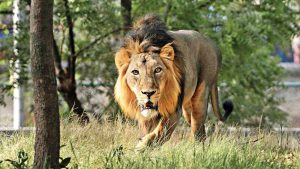
The 16th Lion Population Estimation report (2025) revealed that India’s Asiatic lion population has risen from 674 in 2020 to 891 in 2025.
- It Is A periodic wildlife census that assesses the population, distribution, and demographic trends of the Asiatic lion (Panthera leo persica).
- Conducted By: Gujarat Forest Department
- Supported by the Ministry of Environment, Forest and Climate Change (MoEFCC) under Project Lion.
- Key Estimations (2025):
- Total Population – 891 lions (rise of 32.2% from 2020).
- Adult Females – Increased from 260 to 330 (rise of 26.9%), enhancing reproductive potential.
- Satellite Populations – 497 lions across nine locations including Barda WLS, Jetpur, Babra-Jasdan.
- Corridor Records – First-time sighting of 22 lions in wildlife corridors.
- Highest population: Amreli district – 82 adult males, 117 adult females, 79 cubs.
- Highest growth: Mitiyala WLS (rise of 100%), Bhavnagar Mainland (rise of 84%), South Eastern Coast (rise of 40%).
- Declines: Girnar WLS (loss of 4%), Bhavnagar Coast (loss of 12%).
Bank Credit Growth Slows to 1.4% in FY26:
Bank credit growth in India has slowed to 1.4% in FY26 so far, down from 2.3% in the same period last year, according to the Reserve Bank of India’s latest weekly statistical survey. Meanwhile, deposit growth has remained steady at 3.4%, compared with 3.5% during the same period last year.
For the fortnight ending July 25, 2025,
- Deposits: Up 10.2% year-on-year.
- Advances: Up 10% year-on-year.
- This indicates that while deposit mobilisation remains healthy, lending momentum has softened in the early months of the fiscal.
KSFE Becomes First Miscellaneous NBFC in India to Cross ₹1 Lakh Crore Turnover:
Kerala State Financial Enterprises (KSFE) has achieved a historic milestone, becoming the first miscellaneous non-banking financial company (NBFC) in India to record a business turnover of ₹1 lakh crore. The state-owned firm reached this figure in record time, doubling its turnover from ₹50,000 crore in just four years. To commemorate this landmark achievement, Kerala Chief Minister Pinarayi Vijayan will inaugurate a celebratory event at Central Stadium, Thiruvananthapuram. The event will be chaired by Finance Minister K N Balagopal and will feature, Launch of the ‘KSFE Onam Samriddhi Gift Card’ by Food and Civil Supplies Minister G R Anil. Special appearance by award-winning actor Suraj Venjaramoodu, KSFE’s brand ambassador.
ICICI Bank Records Lowest Attrition Rate Among Private Peers for Three Consecutive Years:
ICICI Bank, India’s second-largest private sector lender, has emerged as the best performer in employee retention among major private banks for the third consecutive year. According to its Business Responsibility and Sustainability Reporting (BRSR) report, the bank’s attrition rate fell to 18% in FY25, down from 24.5% in FY24 and 30.9% in FY23.
While attrition rates have declined across the private banking sector over the past three years, ICICI Bank consistently outperformed its competitors,
- ICICI Bank: 18% in FY25 → 24.5% in FY24 → 30.9% in FY23
- HDFC Bank: 22.6% in FY25 → 26.9% in FY24 → 34.2% in FY23
- Axis Bank: 25.5% in FY25 → 28.8% in FY24
- Kotak Mahindra Bank: 33.3% in FY25 → 39.6% in FY24
- IndusInd Bank: 29% in FY25 → 37% in FY24 → 51% in FY23
Sikkim CM Launches ‘Nari Adalat’ on 1st Amma Samman Diwas to Empower Women in Local Justice:
On the occasion of the first Amma Samman Diwas, Sikkim Chief Minister Prem Singh Tamang inaugurated ‘Nari Adalat’ at Rongpo. This innovative, women-led community justice forum is designed to provide accessible, informal, and empathetic conflict resolution, particularly for rural and semi-urban communities in Sikkim.The core idea behind ‘Nari Adalat’ is to empower women to take charge of resolving disputes and addressing social issues that directly affect them. By providing a supportive, non-intimidating environment, the initiative allows conflicts to be settled locally, without relying solely on the formal judicial system, which can be slow, expensive, and intimidating for many.
Maharashtra Launches ‘Disha Abhiyan’ for Uniform Education of Students with Intellectual Disabilities:
Maharashtra has taken a pioneering step in inclusive education by successfully implementing ‘Disha Abhiyan’, a programme designed to provide uniform and quality education for students with intellectual disabilities. Announcing the initiative, Chief Minister Devendra Fadnavis stated that it has already been rolled out across 453 special schools in the state.Maharashtra is the first state in the country to adopt a state-wide, standardised curriculum tailored for students with intellectual disabilities. Developed by the Jai Vakil Foundation and approved by the National Institute for the Empowerment of Persons with Intellectual Disabilities (NIEPID), this initiative ensures that students across all special schools receive consistent, research-based learning experiences.
WHO Declares Kenya Free of Sleeping Sickness:
The World Health Organization (WHO) has officially certified Kenya free of human African trypanosomiasis (HAT)—commonly known as sleeping sickness—as a public health challenge. This milestone makes Kenya the 10th country to achieve elimination status, marking a significant victory in the fight against neglected tropical diseases (NTDs)WHO Director-General Dr. Tedros Adhanom Ghebreyesus congratulated the government and people of Kenya on their success. He noted that Kenya’s achievement is part of a broader continental effort to make Africa free of neglected tropical diseases, improving the lives of millions.




